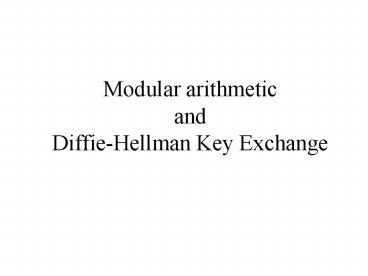Modular arithmetic and DiffieHellman Key Exchange PowerPoint PPT Presentation
1 / 20
Title: Modular arithmetic and DiffieHellman Key Exchange
1
Modular arithmeticand Diffie-Hellman Key
Exchange
2
A very common techniquemodular arithmetic
- Normal arithmetic
- 5 5 25
- 25 / 5 5
- Modular arithmetic (mod 21)
- 5 5 4
- 4 / 5 5
- Of course, we can use any integer modulo not
only 21
3
More modular arithmetic (mod 21 still)
- Addition 1214 26 5
- Additive inverse (what do I need to ADD to
- 2 if I really want to SUBTRACT 5?)
- - 5 21 - 5 16
- 2-5 21618
4
And yet some more
- Multiplicative inverse (what do I need to
- multiply 6 by if I really want to divide by 2?)
- 112 22 1, therefore 112-1
- How can we find multiplicative inverses? Either
try all possibilities, or use the Extended
Euclidian Algorithm.
5
One more important operation
- Exponentiation 53 (55)5 45 20
- (still modulo good old 21)
6
Now to an interesting fact
- Additive inverses are easy to find.
- Multiplicative inverses are easy to find.
- Exponentiation inverses (called discrete
logarithms) are NOT easy to find! - What does this mean? A one-way function! )
7
One more interesting thing
- If I give you three values, g, gx and gy, you
cannot compute gxy unless you know either x or y
but if you do, then it is easy! (All modulo
some integer, as usual.) - (This is referred to as the Diffie-Hellman
assumption.)
8
So how can we use any of this???
9
A word about encryption
- Using a public key encryption scheme (such as
RSA), the sender only has to know the receivers
public key. - If a symmetric key encryption scheme (such as
AES) is used, the sender and receiver has to
first agree on a key that they both know. - Symmetric key ciphers are much faster than public
key ciphers.
10
How can we agree on a symmetric key?
- If the recipient has a public key then key
transport can be done the initiator (sender)
picks a symmetric key K, encrypts it using the
recipients public key, sends the result over. - If both have public keys, then Diffie-Hellman
key exchange can be performed. - If neither what can be done then?
11
Diffie-Hellman Key Exchange (part 1)
- System parameters p is a large prime,
- g is a generator of Gp
- Alice has a secret key xA, a public key yA, where
yAgxA mod p - Bob has a secret key xB, a public key yB, where
yBgxB mod p
12
Diffie-Hellman Key Exchange (part 2)
- Alice computes KAyBxA mod p
- Bob computes KByAxB mod p
- Now, notice that modulo p, we have that
- KA(yB)xA (gxB)xA
- (gxA)xB (yA)xB KB
- Like magic Alice and Bob share a key!
13
Diffie-Hellman Key Exchange (part 3)
- But is it secure? That is, would an eavesdropper
(Cindy) be able to compute KA (KB) if she knows
yA and yB and observes all interaction? - First of all there is no interaction!
- So the question is given gxA mod p and gxB mod
p, can Cindy compute gxAxB mod p?
14
But here is a problem (called the
man-in-the-middle attack)
- Alice wants to talk to Bob, sends her public key
to Bob. - But Cindy intercepts it, and replaces Alices
public key with hers. She sends this to Bob. - Bob thinks Alice wants to talk to him. He sends
his public key to her. - But Cindy intercepts and replaces!
- Then Cindy sets up shared keys with both!
15
What can we do?
- If the public keys are certified (see e.g.,
VeriSign) then Alice and Bob verifies that they
got the right public keys! - If not (or if Alice and Bob just created the
secret and public keys for this exchange), can
anything be done?
16
The Problem of Pairing
?
- Key pairing problem (KA KB )
- (verify that there is no man-in-the-middle)
17
Mahers solution(patent 5,450,493 , search USPTO)
- Alice and Bob perform a DH key exchange, then
- Alice computes a f(KA) and
- Bob computes b f(KB),
- where f compresses.
- (Note that Cindy can also compute (a,b).)
- 2. Then, Alice and Bob compare a and b
usinganother channel (such as voice). Note that
theycannot use the same as for key exchange! - 3. If different, stop, otherwise ok.
18
Problems with Mahers solution(not published as
far as I know)
- Eve knows f! She generates secret keys xE1, xE2
and public keys yE1gxE1, and yE2gxE2. - Eve knows Alice and Bob will compare f(yE1xA) and
f(yE2xB) - Eve checks if these are equal if not, goes to
1. - 4. Then she sends yE1 to Alice and yE2 to Bob.
- 5. She knows they will get the same check
value! Now they are tricked to share a key with
her!
19
How can we fix this?(first solution)
- Let Alice and Bob select a (rather short) random
number r over another channel (voice, etc.) - 2. and compare a f(KA,r) and b f(KB,r)
- 3. Now, to cheat, Cindy has to anticipate r (or
be lucky!)
20
How can we fix this?(second solution)
commitment (K , shared-PIN, r2 )
r1
check
r2
check

